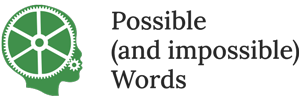
Sounds – or letters?
Not the same thing
What children most often most obviously get wrong
Children don’t initially get all the sounds of speech right. They often replace one speech sound or ‘phoneme’ by another, saying car as TAR or GAR or DAR. Because letters are familiar, it might appear that this is what they are muddling.
The notion of letters was by the extraordinary discovery of one scholar working in the Middle East about 3,200 years ago. By this discovery, the root form of every word could be broken down into a sequence of consonants because then, as now, the languages in this part of the world have the unusual property that vowels are mainly or only inserted by derivation – essentially for speech – rather than being part of entries in the lexicon. At this point letters represented consonants as one of two sorts of speech sound or phoneme. But this profound insight would be gradually lost as attempts were made to adapt existing systems for languages for which they were not primarily designed.
About 300 years after the original discovery, it was discovered that this could be applied to the full spoken form of all phonemes, including the vowels in Greek, a more typical language, with vowels as well as consonants in the lexical entry. About 300 years after the application to Greek, it seems to have been worked out, possibly by an Etruscan scholar, that the phonemes can be broken down further into constituent gestures or features, at least with respect to M, B, N and D. Almost 2,000 years later. from a first suggestion by William Holder in the 17th century, more studies by William Jones in the 18th century, and then by much more extensive work of the 19th and 20th centuries it became clear that the commonalities were across languages, and the notion of commonalities across systems of phonemes differing by a universal set of features was developed and refined, initially by Noam Chomsky and Morris Halle (1968) widely known as SPE. But by this point, the original insight had been lost, especially in English. Letters were just representations of phonemes for the special purpose of writing.
The lost insight of the alphabet
By the proposal here, as by Nunes (2002), it is necessary to consider how and why the phonemic structure evolved in the way it has, and how this is reflected in human development. Part of the story here is obviously the anatomy and neurophysiology of the vocal tract. But that is only part of the story. It is also necessary to consider the interaction between the features and the rhythm of words ‘built’ by successive steps. English does this in a very marginal way by doubling the PP in happy, where it is both at the end of one syllable and the beginning of the next, where the two syllables together constitute a foot.
The letters of the alphabet represent the notion of the phoneme as this was originally and brilliantly conceived in the Middle East. To Gallileo and to Noam Chomsky, the discovery of the alphabetic principle is one of the crowning achievements of human thought. But as speech and languages developed over centuries, the profound and original notion of the alphabet was obstructed by a common reluctance to update spellings and by a common preference for some prestigious system, as represented by Latin or Greek . So, using a system bequeathed by Latin, English makes do with five single letters for a system with the six short vowels in him, hem, ham, hum, hod and hood, and the unstressed vowel, known as ‘schwa’, at the beginning and end of agenda.
In 1875 the Polish scholar, Jan Baudouin de Courtenay, reawakened interest in the original insight, and in the 1920s opened the world’s first institution dedicated to the training of speech and language pathologists in Warsaw.
It would seem that Baudouin de Courtenay was the only linguist to have ever been nominated as the president of his country.
Contrasting views
By what might be called a taxonomic view (not adopted here), the phonemes are grouped by the smallest possible number of their constituents, most commonly the place in the vocal tract where they are articulated, the relative timing of any activity in the larynx or voice-box, and the manner in which the articulation happens. This gives a large number of places, the two lips, the lower lip and the upper teeth, the tongue tip and the upper teeth, and so on, and a large number of manners, as a single articulation, as in tea, or a transition between two, as in chore, or an articulation which is neither a vowel nor a consonant, like the Y in yew, or both a vowel and a consonant like the L in law.
This approach describes the phonemes, but does little to clarify why children make the quite narrowly-defined set of errors which they commonly do, replacing K by T and G by D, R by W, and Y by L, but rarely replacing R by Y or T by K.
By another approach, known as ‘articulatory phonology’, the alphabet is just a convenience, reflecting what are really just overlapping sequences of gestures within the vocal tract. If this theory is correct, the alphabet is just an artifact of perception. To my mind, this does not illuminate the actual distribution of speech errors, neither children’s nor adults’.
Here I follow the assupmtion by SPE and previously by Holder, that the only well-defined entity is what is stored as a seres of features in the human mind, approximately represented by a phoneme. The order of definition is important.
(See Phonetics, Phonology and Phonotactics).

